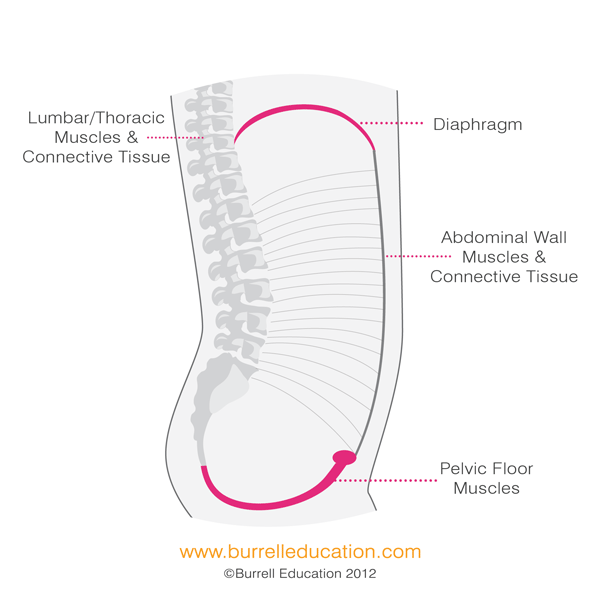I’m a firm believer that knowledge is power. To regain control of your body and get back to doing the activities you love, knowing how the body works can really help in understanding the reasons behind WHY certain routes to recovery are recommended and being able to embody the changes needed.
Often we lose connection with our bodies developing habits that are not facilitative to how our ‘Core’ works for us. It’s not surprising really. The ‘core’ is an area of the body that should work for us without us having to think about it. Our ‘core’ should be REFLEXIVE i.e. able to actively support our bodies during different activities.
Let’s take a deeper look in order to understand how your Core should work for you
Think of your Core like an inflated balloon
In the image you can see the representation of the ‘Core’.

Our respiratory diaphragm is at the top of the balloon and the pelvic floor muscles are at the bottom of the balloon. These muscles are mirror images of each other. The deep abdominal muscles wrap around the centre of the balloon connecting the top and the bottom.
Imagine that your ‘core’ takes the shape of this balloon. The skin of the balloon represents three sets of muscles: our respiratory diaphragm, our deep abdominal muscles, and our pelvic floor muscles. All three muscles work together and manage the pressure that naturally exists in the abdomen.
When all aspects within that imaginary balloon work well together they engage with each other and are able to respond to our movements correctly and changes in pressure e.g. sneezing, coughing, jumping, lifting, running, etc, automatically. This is our ‘Reflexive Core’ system working as it is designed to do.
How do we know if the Core is working Reflexively?
When the ‘Core’ is not supporting our bodies effectively we can go on to develop symptoms. These can include:
• Urinary incontinence. These are the embarrassing involuntary leaks.
• Urinary urgency. An intense urge to wee – not always accompanied by urination.
• Urinary frequency. Needing a wee more than 7 times a day and you may need to visit the bathroom during the night too.
• Pelvic organ prolapse. A feeling of heaviness/pressure into the pelvis or vagina.
• Bowel changes. Needing to use the toilet urgently and/or frequency or suffering from constipation.
• Pain. This can be experienced in the pelvis, lower back, hip, perineum, c-section scar area and during intercourse.
What disrupts the core from working reflexively?
Here are 9 of the most common reasons why our core struggles to be reflexive.
• A diastasis recti or tummy tap. This is a separation down the middle of the abdomen/balloon.
• A c-section or perineal scar tissue. This can disrupt the flow of information through the ‘core’ reducing the elasticity of the tissues resulting in the inner balloon being less flexible.
• Underactive pelvic floor muscles. This is when the pelvic floor muscles become too weak to hold the bottom of the balloon leaving them unable to respond to pressure change.
• Overactive pelvic floor muscles. This is when the pelvic floor muscles are too tight and have lost their elasticity. This weakness prevents them from generating any pressure change and stops them from coordinating with other core muscles.
• Constantly holding in the tummy. By holding in your tummy, you are forcing the pressure changes downwards onto the pelvic organs. This squeezes the middle of the balloon causing the top and the bottom to bulge.
• Breathing from your belly. Belly breathing cause the belly to bulge and increases pressure in the abdomen. Pressure finds the path of least resistance, usually downwards (pelvic organs) or abdomen which can weaken the lining of the balloon.
• Changes in postural alignment. Poor posture disrupts the optimum body alignment i.e. ribs over pelvis. This reduces ‘core’ communicating effectively with each other.
• Movement patterns and habits. The way we move, and exercise, impacts the effectiveness of our core. While exercising is assumed to always be good for us, when done incorrectly, it can have the opposite effect and if you were to develop, and repeat, poor techniques you can over time cause more harm than good.
• Hormone changes. Never ever underestimate the power of our hormones! As we enter different life stages our hormone levels shift and this has an impact on the tissues that support the core muscles.
Taking a whole body training approach will keep your core healthy
To reduce and resolve any symptoms of core dysfunction you need to identify the fault and find a way to correct it. However, this cannot be done in isolation of the whole body. Assessing, addressing, and treating the body as a whole is key to experiencing a long lasting and sustainable resolution to your symptoms.
If you’d like help learning more about how you can address your symptoms feel free to email me at info@ormskirkpilates.co.uk.

Recent Comments